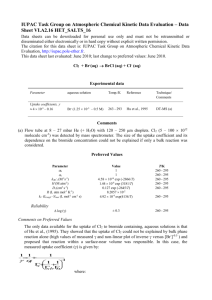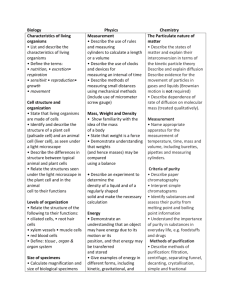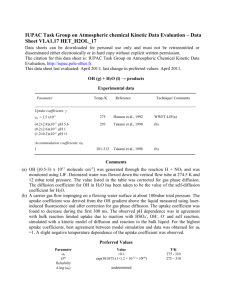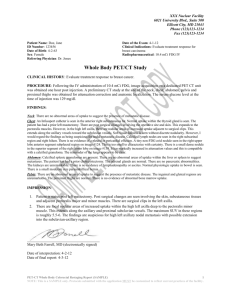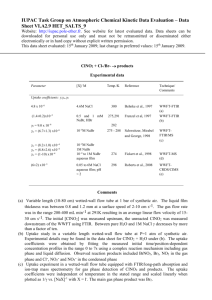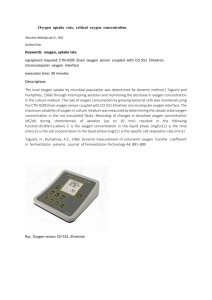Word - IUPAC Task Group on Atmospheric Chemical Kinetic Data
advertisement
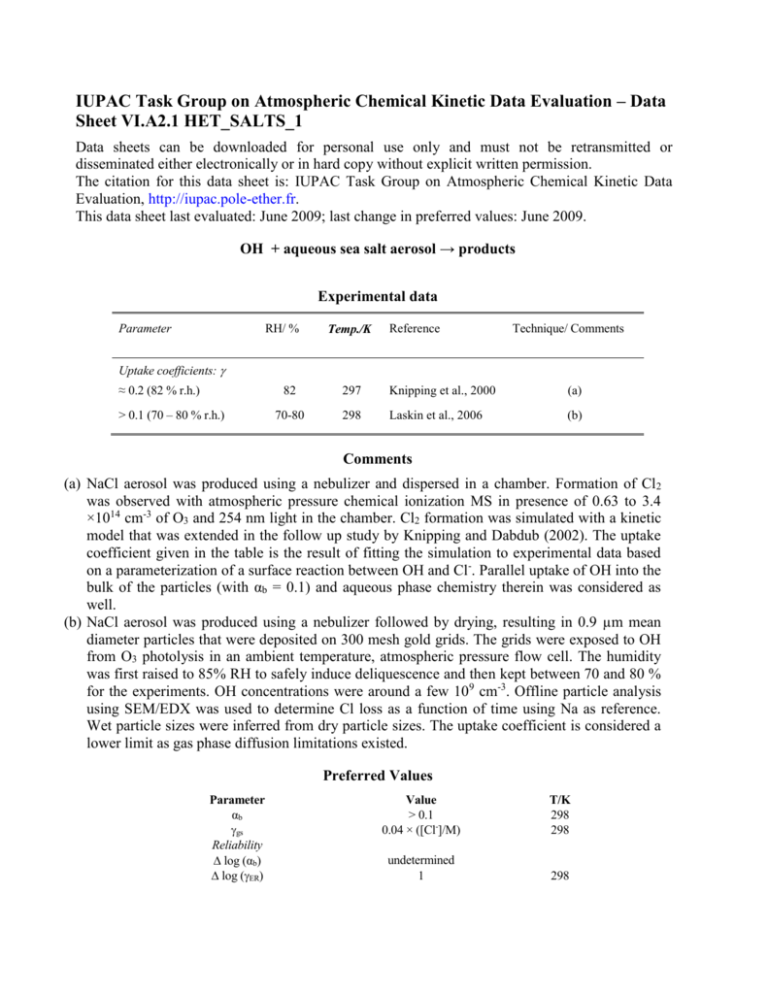
IUPAC Task Group on Atmospheric Chemical Kinetic Data Evaluation – Data Sheet VI.A2.1 HET_SALTS_1 Data sheets can be downloaded for personal use only and must not be retransmitted or disseminated either electronically or in hard copy without explicit written permission. The citation for this data sheet is: IUPAC Task Group on Atmospheric Chemical Kinetic Data Evaluation, http://iupac.pole-ether.fr. This data sheet last evaluated: June 2009; last change in preferred values: June 2009. OH + aqueous sea salt aerosol → products Experimental data Parameter RH/ % Temp./K Reference Technique/ Comments Uptake coefficients: ≈ 0.2 (82 % r.h.) > 0.1 (70 – 80 % r.h.) 82 297 Knipping et al., 2000 (a) 70-80 298 Laskin et al., 2006 (b) Comments (a) NaCl aerosol was produced using a nebulizer and dispersed in a chamber. Formation of Cl 2 was observed with atmospheric pressure chemical ionization MS in presence of 0.63 to 3.4 ×1014 cm-3 of O3 and 254 nm light in the chamber. Cl2 formation was simulated with a kinetic model that was extended in the follow up study by Knipping and Dabdub (2002). The uptake coefficient given in the table is the result of fitting the simulation to experimental data based on a parameterization of a surface reaction between OH and Cl-. Parallel uptake of OH into the bulk of the particles (with αb = 0.1) and aqueous phase chemistry therein was considered as well. (b) NaCl aerosol was produced using a nebulizer followed by drying, resulting in 0.9 µm mean diameter particles that were deposited on 300 mesh gold grids. The grids were exposed to OH from O3 photolysis in an ambient temperature, atmospheric pressure flow cell. The humidity was first raised to 85% RH to safely induce deliquescence and then kept between 70 and 80 % for the experiments. OH concentrations were around a few 109 cm-3. Offline particle analysis using SEM/EDX was used to determine Cl loss as a function of time using Na as reference. Wet particle sizes were inferred from dry particle sizes. The uptake coefficient is considered a lower limit as gas phase diffusion limitations existed. Preferred Values Parameter αb gs Reliability log (αb) log (ER) Value > 0.1 0.04 × ([Cl-]/M) T/K 298 298 undetermined 1 298 Comments on Preferred Values The only direct experimental investigation of the reaction of OH with deliquesced NaCl provides a lower limit to the uptake coefficient (Laskin et al., 2006). The chamber experiment by Knipping et al. (2000) provided evidence for formation of Cl2 from the reaction of OH with deliquesced NaCl due to an overall reaction (R1). OH + Cl- → 0.5 Cl2 + OH(R1) In the bulk aqueous phase, the initial reaction of OH is believed to be (Finlayson-Pitts, 2003) OH + Cl- → ClOHk2 = 4.3 × 109 M-1 s-1 at pH 2 (R2) Known bulk aqueous phase kinetics was unable to explain Cl2 formation in the study by Knipping et al. (2000) and later by Knipping and Dabdub (2002). Therefore, an Eley-Rideal type surface reaction was proposed to bring experiment and simulation into agreement, which is recommended in parameterized form as a function of the chloride concentration. Note that in this case the surface process acts parallel to bulk accommodation and bulk reaction: 1 1 1 4 HR T ' D gs b lk b with c b b where kbI is the first order rate coefficient in the bulk aqueous phase, e.g., due to reaction (R2). However, in many cases multiple reactions may occur in parallel in the bulk. For the Henry’s Law constant it is suggested to use the value recommended for pure water (see data sheet VI.A1.17, this evaluation). Evidence for the formation of OH- was provided by Laskin et al. (2003) and by Shaka et al. (2007), who demonstrated formation of OH- in deliquesced MgCl2. For αb, we recommend the same lower limit as for dilute aqueous solutions. On dry sea salt, measured uptake coefficients are on the order of 10-2 as reviewed by Rossi (2003) and Finlayson-Pitts (2003). Recently, the humidity dependence of the uptake coefficient of OH with sea salt was observed to be consistent with the humidity dependent uptake of OH on MgCl2 and CaCl2, the low deliquescing components of sea salt (Park et al., 2008, 2009), consistent with a much higher OH loss at the surface of hydrated halides. References Finlayson-Pitts, B. J.: Chem. Rev., 103, 4801-4822, doi:10.1021/cr020653t, 2003. Knipping, E. M., and Dabdub, D.: J. Geophys. Res., 107, 2002. Knipping, E. M., Lakin, M. J., Foster, K. L., Jungwirth, P., Tobias, D. J., Gerber, R. B., Dabdub, D., and Finlayson-Pitts, B. J.: Science, 288, 301-306, 2000. Laskin, A., Gaspar, D. J., Wang, W., Hunt, S. W., Cowin, J. P., Colson, S. D., and FinlaysonPitts, B. J.: Science, 301, 340-344, 10.1126/science.1085374, 2003. Laskin, A., Wang, H., Robertson, W. H., Cowin, J. P., Ezell, M. J., and Finlayson-Pitts, B. J.: J. Phys. Chem. A, 110, 10619-10627, 2006. Park, J. H., Ivanov, A. V., and Molina, M. J.: J. Phys. Chem. A, 112, 6968-6977, 2008. Park, J.-H., Christov, C. I., Ivanov, A. V., and Molina, M. J.: Geophys. Res. Lett., 36, 2009. Rossi, M. J.: Chem. Rev., 103, 4823-4882, 2003. Shaka, H., Robertson, W. H., and Finlayson-Pitts, B. J.: Phys. Chem. Chem. Phys., 9, 19801990, 2007.
